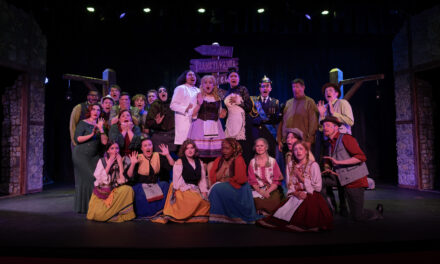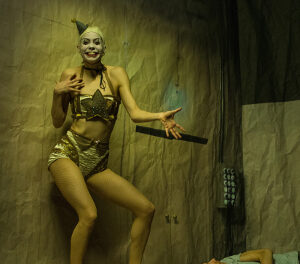Rennie Harris is no stranger to American Dance Festival, having brought the Rennie Harris Puremovement American Street Dance Theater four times now. Based out of Philadelphia, Harris (b.1964) is an authentic voice for Hip-hop culture and dance. He has risen to become a leading authority, calling awareness to the cultural, educational, and high art validity of Hip-hop on a global scale.
Harris and his company’s visit to the Bull City tonight was especially significant, as he was presented with the 2023 Samuel H. Scripps/American Dance Festival Award for Lifetime Achievement – the first ever given to a Hip-hop artist. Presenting the award was longtime friend of both ADF and Harris, Robert Battle, Artistic Director for the Alvin Ailey American Dance Theater. This $50,000 prize has been well-earned by Harris whose “street dance theatre” has been hard at work bringing Hip-hop/street dance to mainstream audiences for 31 years. Harris accepted the honor with the humble graciousness of a gentle giant – bravo!
The program for the evening was entitled Nuttin’ But A Word. In this work, Harris has built upon the initial foundations (both in movement and in concept) of Hip-hop/street dance and its culture, to create an 8-movement suite that explores what Harris contends are the three laws of Hip-hop – individuality, creativity, and innovation.
The eight Puremovement dancers casually gathered in a circle center stage for “Continuum” as if meeting on the street to “introduce” themselves by way of “topstepping” and as a warm-up for what was to be their mind-blowing output of pure vivacity and power for the next hour. Their playful energy was contagious with audience engagement right away, which answered my question about how one can bring a communal art form to the stage and create the same effect as it would have on a street corner. It works primarily because Harris has seen to it that they “keep it real.”
It did not take long before this first-rate company were expending so much energy I wondered how their hearts could not explode – and they kept going! While portions of movements were obviously (and beautifully) choreographed, others seemed almost completely improvised. It was clear that, unlike a great deal of dance that is precisely calculated, these individuals had the mandate to create something new every time they walked on stage.
This writer was struck by the extraordinary attention to detail and expression of very complex and often hidden musical aspects brought out in the choreography. There were numerous examples, but one of note was in the fourth movement, “Bent” which uses Al Jarreau’s rendition of Dave Brubeck’s “Blue Rondo á la Turk” – taken at breakneck speed in 9/8 time (mostly). The Jarreau vocal solo lines were traded off by each dancer (Miyeko Urvashi, Emily Pietruszka, Fyness Mason, Rachel Snider, and Maggie Waller – all standouts) with insanely innovative expressions of footwork that left this viewer rendered speechless. I was awe-struck by the musicality of the choreographer and by the preternatural virtuosity of these young dancers.
Harris not only gives the audience an opportunity to vicariously experience the joy and creativity of an art form that few of us would have necessarily witnessed “live” since its emergence in the 1970s, such as toprock, downrock, freezes, power moves, drops, and locking, he also creates stories to help the audience better understand the circumstances under which this art form was birthed – as a way of community building in places that suffered (and still do) under the weight of institutional racism.
In the penultimate movement “Doubt & Dolo,” Harris recreates a street scene in which one young man (Joshua Culbreath) waits in the twilight for his friend (Phillip Cuttino, Jr.) to join him. They mime what they observe going on in the neighborhood, joke around, show off some moves – you can sense that their friendship keeps them tethered to the Earth. As one would expect, some trouble occurs and Cuttino’s character is shot dead by an unseen assailant. Culbreath’s character expresses the unbearable suffering and pain through a heartbreaking and protracted performance of his grief. Backed by “I Need You Now” by Smokie Norful, this impactful piece brought home how delicate and beautiful human beings are, both in their individuality and in what they mean to one another. The lighting design in this piece (by Bob Steineck) had to be seen to be fully appreciated, and was excellent and moving.
I always regret that in most dance programs there isn’t more information about the music. While the selections were carefully curated, it is never easy to locate the audio tracks when searching after the concert – this one was no exception.
The ADF website and ticket information stated that there would be a post-performance discussion with the artists, but that did not happen unfortunately, as I had several follow up questions and quite a few were waiting around for it.
Kudos to the b-boys and b-girls of Rennie Harris Puremovement Street Dance Theater for their brilliant performance. As always, ADF and executive director Jodee Nimerichter are to be thanked and commended for always bringing the best of American contemporary dance to the festival, now in its 90th year!
The ADF summer season continues through July. See our calendar for details on each event.













